I’ve also been having this problem. I think it can take quite a while sometimes before the agent wakes up after the desktop unsuspends. As you say, most of the time users can connect if they try a couple of times.
However sometimes they can’t connect until they call us and we reboot the VM. This is a major problem, as there is nothing the user can do until we’ve rebooted it. I’ve had SRs with VMWare who couldn’t find anything.
This is holding back our VDI deployment, until users can log on reliably we can’t take it any further.
If anyone has any solutions/seen this before I would be very grateful!!
(Another problem is patching/updating VMs that are suspended and essentially never reboot).
We’re experimenting with some users using the Win32 client to connect rather than thru the browser/portal. It’s too early to say for sure, but so far it looks like the win32 client users are having no connectivity issues, while the browser users are still grumbling.
I have deployed view on our environment, it works like a charm — 70 linked clones on multiple WAN offices
When I was doing the pilot , I experiance the same issue, the way to fix the issue is — see my settings below, you will notice I power off VMs after they are used (DON»T suspend it), also, you need to calculate the right «Number of Desktops (available)» accurately. For my deployment, when I create the desktop pool for a training room, I usually I keep the available number high (since I assume there is a higher probability, that many users will login at the same time — more resource intensive) but when I deploy it for a remote office, I can keep the available number lower — since not all users will login at the same time.
Number of desktops (minimum): 1
Number of desktops (maximum): 17
Number of desktops (available): 8
Stop provisioning on error: Yes
VM naming pattern: vm-ebtrn-A
When VM is not in use: Power off when not in use
Power off and delete virtual machine after first use: No
Automatic logoff after disconnect: Immediately
Allow users to reset their desktop: False
Please award points, if you find this post helpful.
Hi,
Did you try my recommendation to switch to PowerOff instead of suspend — you will get more consistent behavior that way. Also, just try increasing minimum number of available desktop. I have more that 70 linked clones presented over 2 IBM 3650 quad servers — none of my users are getting pool unavailable messages.
If you find my recommendation helpful, please consider awarding points.
I am trying a few suggested changes today. One of which will be the power off instead of suspend mode option. Since we are using a persistent pool, I don’t think the number of available desktops will apply in our configuration. I’ll post all changes and results tomorrow after users have had a chance to log in.
Thanks for the suggestions thus far.
Great, looking forward to hearing back from you.
Thanks,
Meraz
You should be able to apply my suggested changes even in the persistent pool (automated) — I just tested it — by default it doesn’t show — you need to click the advanced tab to see it.
Provisioning Settings
Under the advanced Settings
Check the box : Enable Advanced Number of Desktops Settings
Number of desktops (minimum):
Number of desktops (maximum):
Number of desktops (available):
Please award points, if you find this post helpful. — Thanks.
I think the point about persistant pools and minimum number of available desktops is that users always get the same desktop. The min available number would only apply if large numbers of new, previously unseen users were loggin on at once. For existing users it has no effect.
The problem with shutting down is it takes a few min for the destop to boot, during which the user gets no feedback on what is happening (eg, on a normal PC you can see it loading, on a thin client it just sits there saying «connecting» for ages). Also one of the features of VDI for us is that someone can disconnect their desktop, go home and get it back exactly as it was when they left. If the desktop was to shutdown whenever someone disconnected I think we would have lots of upset users who went to meetings and came back to find their desktop has been killed..
I think there are bugs in the agent/manager. I’m running a scripted automated logon at the moment which firstly monitors the entire setup and then emails me if it fails, so this will pick up any failures in the entire server stack (View server, vCenter server, SQL server) and alerts if it fails to logon so I can try and get a VM to test against. Restarting the agent doesn’t help, the entire VM has to be rebooted for them to logon again.
Number of desktops (minimum): 1
+ Number of desktops (maximum): 17+
Number of desktops (available): 8
+ Stop provisioning on error: Yes+
+ VM naming pattern: vm-ebtrn-A+
+ When VM is not in use: Power off when not in use+
+ Power off and delete virtual machine after first use: No+
Automatic logoff after disconnect: Immediately
+ Allow users to reset their desktop: False+
I am new out here and to VMWare, so you will have to excuse my ignorance on things out here for awhile. I am in the process of learning VMWare. I have a problem similar to the one mentioned here, where are these above settings accessed?
Thanks in advance for any and all help!
Hi All,
Is this issue already solved in vmware view 4.0.1? We’re testing view using view 4.0.0 Build-210939 and experiencing the same issue and pretty annoying. Sometimes no user can be connected at all even if we’re resetting their desktop, and only can be solved if we also reset the view manager server. User desktop is a plain WIndowsXP VMs in vSphere 4.0.0 Buil-16400. We can’t use mnasir suggestion due to our application behavior, makes it impossible for us to auto-logoff after user disconnect.
Here’s our view configuration:
Desktop Persistence: Persistent
Type: Manual Pool
When VM not in use: Do Nothing
Automatic Logoff after disconnect: Never
Active Desktop : 4
Total Desktop Source: 7
looking forward for any suggestion…
Thanks
Hi, we have been experiencing the same problem, it seems to have been triggered by a virtual center database unexpected shutdown. Following recovery of the database and ensuring VC and View Connection servers were up and fine, a few users started to get the message «The assigned desktop source for this desktop is not currently availble» at logon from their thin client. I suspect this only happens with users that do not logoff (they disconnect or shutdown thin client) but it is not replicable in a consistent manner.
Restarting the View agent did not fix the problem (even though I may not have waited long enough) but rebooting the virtual desktop fixes it always. This problem is also impacting our full deployment of the virtual desktop infrastructure.
We had been using View 4.0.0 and our next step is to upgrade to 4.0.1, anybody knows if the new version fixes the problem?, this seems to have been lingering around for a while.
Cheers,
>Number of desktops (minimum): 1
>+ Number of desktops (maximum): 17+
>Number of desktops (available): 8
>+ Stop provisioning on error: Yes+
>+ VM naming pattern: vm-ebtrn-A+
>+ When VM is not in use: Power off when not in use+
>+ Power off and delete virtual machine after first use: No+
>Automatic logoff after disconnect: Immediately
>+ Allow users to reset their desktop: False+
>I am new out here and to VMWare, so you will have to excuse my ignorance
on things out here for awhile. I am in the process of learning VMWare.
I have a problem >similar to the one mentioned here, where are these
above settings accessed?
Hi MechaMan,
In VMWare View Manager 4.0, these settings are located under Desktop and Pools, Summary tab of a selected pool… here are some screenies.. 


Mike… VM, Virtually!!
Mike… VM, Virtually!!
I tried your suggestions and I am still having the problem.
My admin account will always work. It’s domain user accounts that will work
then stop working and recieve the «assigned desktop source for the desktop is not currently availble.
Any place I need to add user permissions? But why would it work then stop.
Then start working again?
Hi
Have you got any solution for the issue mentioned.we have vmware horizon 7 and everyday morning people are calling for the desktop unavailable issue.
The desktop is pinging and even in the console it shows the user is logged in if we try a admin account.in view admin console it shows agent unreachable.
- Mark as New
- Bookmark
- Subscribe
- Mute
- Subscribe to RSS Feed
- Permalink
- Report Inappropriate Content
I’ve also been having this problem. I think it can take quite a while sometimes before the agent wakes up after the desktop unsuspends. As you say, most of the time users can connect if they try a couple of times.
However sometimes they can’t connect until they call us and we reboot the VM. This is a major problem, as there is nothing the user can do until we’ve rebooted it. I’ve had SRs with VMWare who couldn’t find anything.
This is holding back our VDI deployment, until users can log on reliably we can’t take it any further.
If anyone has any solutions/seen this before I would be very grateful!!
(Another problem is patching/updating VMs that are suspended and essentially never reboot).
- Mark as New
- Bookmark
- Subscribe
- Mute
- Subscribe to RSS Feed
- Permalink
- Report Inappropriate Content
We’re experimenting with some users using the Win32 client to connect rather than thru the browser/portal. It’s too early to say for sure, but so far it looks like the win32 client users are having no connectivity issues, while the browser users are still grumbling.
![]()
- Mark as New
- Bookmark
- Subscribe
- Mute
- Subscribe to RSS Feed
- Permalink
- Report Inappropriate Content
I have deployed view on our environment, it works like a charm — 70 linked clones on multiple WAN offices
When I was doing the pilot , I experiance the same issue, the way to fix the issue is — see my settings below, you will notice I power off VMs after they are used (DON»T suspend it), also, you need to calculate the right «Number of Desktops (available)» accurately. For my deployment, when I create the desktop pool for a training room, I usually I keep the available number high (since I assume there is a higher probability, that many users will login at the same time — more resource intensive) but when I deploy it for a remote office, I can keep the available number lower — since not all users will login at the same time.
Number of desktops (minimum): 1
Number of desktops (maximum): 17
Number of desktops (available): 8
Stop provisioning on error: Yes
VM naming pattern: vm-ebtrn-A
When VM is not in use: Power off when not in use
Power off and delete virtual machine after first use: No
Automatic logoff after disconnect: Immediately
Allow users to reset their desktop: False
Please award points, if you find this post helpful.
![]()
- Mark as New
- Bookmark
- Subscribe
- Mute
- Subscribe to RSS Feed
- Permalink
- Report Inappropriate Content
Hi,
Did you try my recommendation to switch to PowerOff instead of suspend — you will get more consistent behavior that way. Also, just try increasing minimum number of available desktop. I have more that 70 linked clones presented over 2 IBM 3650 quad servers — none of my users are getting pool unavailable messages.
If you find my recommendation helpful, please consider awarding points.
- Mark as New
- Bookmark
- Subscribe
- Mute
- Subscribe to RSS Feed
- Permalink
- Report Inappropriate Content
I am trying a few suggested changes today. One of which will be the power off instead of suspend mode option. Since we are using a persistent pool, I don’t think the number of available desktops will apply in our configuration. I’ll post all changes and results tomorrow after users have had a chance to log in.
Thanks for the suggestions thus far.
![]()
- Mark as New
- Bookmark
- Subscribe
- Mute
- Subscribe to RSS Feed
- Permalink
- Report Inappropriate Content
You should be able to apply my suggested changes even in the persistent pool (automated) — I just tested it — by default it doesn’t show — you need to click the advanced tab to see it.
Provisioning Settings
Under the advanced Settings
Check the box : Enable Advanced Number of Desktops Settings
Number of desktops (minimum):
Number of desktops (maximum):
Number of desktops (available):
Please award points, if you find this post helpful. — Thanks.
- Mark as New
- Bookmark
- Subscribe
- Mute
- Subscribe to RSS Feed
- Permalink
- Report Inappropriate Content
I think the point about persistant pools and minimum number of available desktops is that users always get the same desktop. The min available number would only apply if large numbers of new, previously unseen users were loggin on at once. For existing users it has no effect.
The problem with shutting down is it takes a few min for the destop to boot, during which the user gets no feedback on what is happening (eg, on a normal PC you can see it loading, on a thin client it just sits there saying «connecting» for ages). Also one of the features of VDI for us is that someone can disconnect their desktop, go home and get it back exactly as it was when they left. If the desktop was to shutdown whenever someone disconnected I think we would have lots of upset users who went to meetings and came back to find their desktop has been killed..
I think there are bugs in the agent/manager. I’m running a scripted automated logon at the moment which firstly monitors the entire setup and then emails me if it fails, so this will pick up any failures in the entire server stack (View server, vCenter server, SQL server) and alerts if it fails to logon so I can try and get a VM to test against. Restarting the agent doesn’t help, the entire VM has to be rebooted for them to logon again.
- Mark as New
- Bookmark
- Subscribe
- Mute
- Subscribe to RSS Feed
- Permalink
- Report Inappropriate Content
Number of desktops (minimum): 1
+ Number of desktops (maximum): 17+
Number of desktops (available): 8
+ Stop provisioning on error: Yes+
+ VM naming pattern: vm-ebtrn-A+
+ When VM is not in use: Power off when not in use+
+ Power off and delete virtual machine after first use: No+
Automatic logoff after disconnect: Immediately
+ Allow users to reset their desktop: False+
I am new out here and to VMWare, so you will have to excuse my ignorance on things out here for awhile. I am in the process of learning VMWare. I have a problem similar to the one mentioned here, where are these above settings accessed?
Thanks in advance for any and all help!
- Mark as New
- Bookmark
- Subscribe
- Mute
- Subscribe to RSS Feed
- Permalink
- Report Inappropriate Content
Hi All,
Is this issue already solved in vmware view 4.0.1? We’re testing view using view 4.0.0 Build-210939 and experiencing the same issue and pretty annoying. Sometimes no user can be connected at all even if we’re resetting their desktop, and only can be solved if we also reset the view manager server. User desktop is a plain WIndowsXP VMs in vSphere 4.0.0 Buil-16400. We can’t use mnasir suggestion due to our application behavior, makes it impossible for us to auto-logoff after user disconnect.
Here’s our view configuration:
Desktop Persistence: Persistent
Type: Manual Pool
When VM not in use: Do Nothing
Automatic Logoff after disconnect: Never
Active Desktop : 4
Total Desktop Source: 7
looking forward for any suggestion…
Thanks
- Mark as New
- Bookmark
- Subscribe
- Mute
- Subscribe to RSS Feed
- Permalink
- Report Inappropriate Content
Hi, we have been experiencing the same problem, it seems to have been triggered by a virtual center database unexpected shutdown. Following recovery of the database and ensuring VC and View Connection servers were up and fine, a few users started to get the message «The assigned desktop source for this desktop is not currently availble» at logon from their thin client. I suspect this only happens with users that do not logoff (they disconnect or shutdown thin client) but it is not replicable in a consistent manner.
Restarting the View agent did not fix the problem (even though I may not have waited long enough) but rebooting the virtual desktop fixes it always. This problem is also impacting our full deployment of the virtual desktop infrastructure.
We had been using View 4.0.0 and our next step is to upgrade to 4.0.1, anybody knows if the new version fixes the problem?, this seems to have been lingering around for a while.
Cheers,
![]()
- Mark as New
- Bookmark
- Subscribe
- Mute
- Subscribe to RSS Feed
- Permalink
- Report Inappropriate Content
>Number of desktops (minimum): 1
>+ Number of desktops (maximum): 17+
>Number of desktops (available): 8
>+ Stop provisioning on error: Yes+
>+ VM naming pattern: vm-ebtrn-A+
>+ When VM is not in use: Power off when not in use+
>+ Power off and delete virtual machine after first use: No+
>Automatic logoff after disconnect: Immediately
>+ Allow users to reset their desktop: False+
>I am new out here and to VMWare, so you will have to excuse my ignorance
on things out here for awhile. I am in the process of learning VMWare.
I have a problem >similar to the one mentioned here, where are these
above settings accessed?
Hi MechaMan,
In VMWare View Manager 4.0, these settings are located under Desktop and Pools, Summary tab of a selected pool… here are some screenies.. 


Mike… VM, Virtually!!
Mike… VM, Virtually!!
- Mark as New
- Bookmark
- Subscribe
- Mute
- Subscribe to RSS Feed
- Permalink
- Report Inappropriate Content
I tried your suggestions and I am still having the problem.
My admin account will always work. It’s domain user accounts that will work
then stop working and recieve the «assigned desktop source for the desktop is not currently availble.
Any place I need to add user permissions? But why would it work then stop.
Then start working again?
- Mark as New
- Bookmark
- Subscribe
- Mute
- Subscribe to RSS Feed
- Permalink
- Report Inappropriate Content
Hi
Have you got any solution for the issue mentioned.we have vmware horizon 7 and everyday morning people are calling for the desktop unavailable issue.
The desktop is pinging and even in the console it shows the user is logged in if we try a admin account.in view admin console it shows agent unreachable.
Введение
Для того, чтобы начать пользоваться VMware View, вам еще потребуется:
- Развернутая vSphere (т.е. vCenter и хотя бы один сервер ESX(i)).
- Домен Active Directory, DNS и DHCP.
Формально говоря, можно обойтись без vSphere (например, только ESXi с
бесплатной лицензией) — но тогда View не сможет автоматически
разворачивать новые виртуальные десктопы. Если вдруг этот вариант вас устраивает — то DHCP тоже не обязателен.
Развертывание
этих компонентов остается за кадром. Описанные здесь действия
подразумевают, что у вас уже есть vSphere, AD, DNS, DHCP. Также вам
необходим сервер(обычно ВМ) под View — это Windows 20032008, и эта
Windows должна быть введена в AD. vCenter в AD можно не вводить — для
View это не играет роли. Желательно иметь выделенную ВМ под View — на
vCenter и контроллер домена View устанавливать нельзя, с другими
приложениями возможны конфликты.
Инструкция писалась по
версии 4.5, но для 4.6 годится в полный рост. Самое заметное отличие
4.6 — возможность туннелирования PCoIP трафика. Для этого Conection или
Security сервер View обязан быть установлен на Windows 2008 R2.
Что еще может быть полезным для вас:
- VMware View — страница продукта.
- Официальный форум.
- Вся документация, моя любимая онлайн ее версия.
- pdf версия буржуйской книги Administering VMware View 4.5.
- Утилита, генерирующая пользовательскую нагрузку и замеряющая время реакции — vdi-sizing.com.
- ZeroClient и VMware View — что такое ZeroClient, пример настройки, интересные комментарии.
- Ubuntu linux + VMware View PCoIP — linux версия клиента View с поддержкой правильного протокола.
- Ericom HTML5 Client for VMware View — HTML версия клиента View.
- PCoIP Server Offload Card — решения для увеличения производительности PCoIP на стороне сервера.
- SSL certificates in VMware View environments.
- vSphere Security —
некоторые компании (читай TrendMicro) уже продают решения, которые
позволяют повысить безопасность виртуальной инфраструктуры используя ее
спецвозможности для этого. - TPS vs. Large Pages in real life — способ попробовать значительно снизить потребление памяти в vSphere.
1. Установка и базовая настройка View connection server
В этом разделе несколько слов про установку и базовую настройку View Connection Server.
1.1 Установка
Мы посмотрели в документ VMware View Integration Guide, выполнили необходимые подготовительные шаги.
Это:
· Создание OU для виртуальных десктопов и (если будут использоваться) связанных клонов;
· Настройка restricted groups (надо ли если только PCOIP?);
· Создание учетных записей для view server и, если надо, composer. Их создаем в AD, даем необходимые права в vCenter.
Теперь запускаем установку- vmware-viewconnectionserver-4.5.0-293049.exe

Рисунок 1‑1
Выбираем установку Standart Server. Next, Next, Finish.
Есть возможность установить без вопросов, скормив установщику несколько параметров (в документации стр. 40).
Используются кое-какие порты, они должны быть открыты в брандмауэре.
1.2 Базовая настройка
Интерфейс управления доступен при обращении браузером по адресу
https://viewserver/admin/
после авторизации учетной записью, имеющей права локального администратора в Windows сервера View.
Минимальными настройками являются указание лицензии и добавление информации о vCenter сервере (серверах, если вдруг один View работает с несколькими серверами vCenter).

Рисунок 1‑2
1.3 Создание базы данных событий
На сервере баз данных следует создать базу для хранения событий View.(Это не обязательно для работы, но крайне желательно на случай каких проблем — без нее сложнее будет разобраться)
Например, создадим базу для БД SQL Express, которая используется на сервере vCenter.
Загрузите и установите консоль SQL Server Management Studio Express (для SQL Express 2008 r2). Запустите консоль, вызовите контекстное меню для сервера и зайдите в свойства.
В пункте Security выберите SQL Server and Windows Authentication mode.
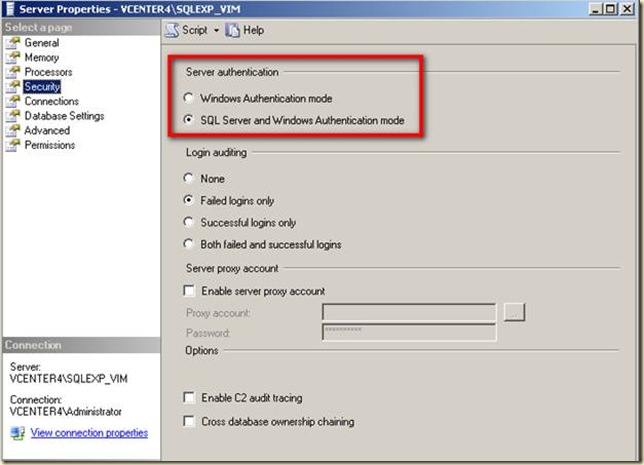
Рисунок 1‑3
Затем вызовите контекстное меню для пункта Databases и выберите New Database. Укажите имя для создаваемой базы, например ViewEvens.
Затем, в консоли SQL Server Management Studio Express пройдите Security -> Logins -> New Login.
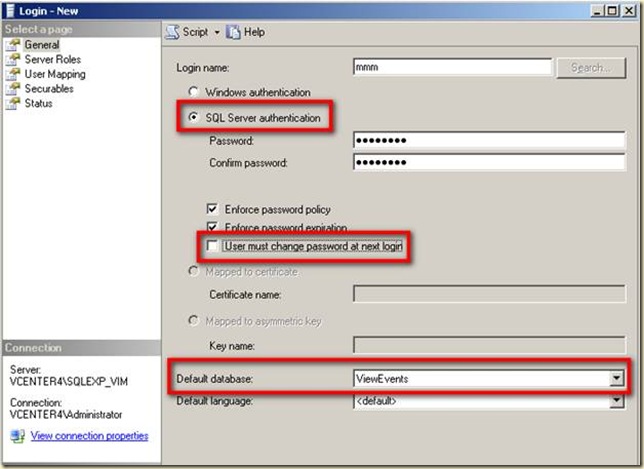
Рисунок 1‑4
(У меня по какой-то причине эта настройка Windows | SQL Server authentication вернулась в значение по умолчанию, так что если у вас не будет получаться — ещё раз ее проверьте.)
Затем выберите пункт User Mapping и укажите как на рисунке:

Рисунок 1‑5
Одним из параметров для дальнейшей настройки является порт, по которому будет идти обращение. Для SQL Express его следует уточнить, запустив оснастку SQL Server Configuration Manager на сервере БД (здесь у меня — на сервере vCenter).

Рисунок 1‑6
Теперь в интерфейсе View укажем параметры для использования этой базы. Нас интересует пункт настроек View Configuration > Event Configuration > Edit. Указываем параметры доступа к созданной ранее базе данных.

Рисунок 1‑7
Для проверки корректной работы системы статусных сообщений, перейдите в раздел Monitoring > Events, в нем вы должны увидеть статус объектов и сообщения.
2. Создание виртуальной машины — основы виртуального десктопа View
Используя интерфейс клиента vSphere, создайте виртуальную машину и установите в качестве гостевой ОС десктопную версию Windows. Есть небольшой нюанс — для десктопной Windows в качестве виртуального SCSI контроллера лучше бы выбрать LSI Logic. А чтобы установщик Windows его увидел — необходимо скачать и подсунуть flp образ с соответствующим драйвером. Этот flp можно найти на vmware.com или на lsi logic.com — вам нужен драйвер для контроллера LSI20320-R. Я пользуюсь вот этим образом — http://download3.vmware.com/software/vmscsi-1.2.0.4.flp.
Теоретически, начиная с 4.1 для WinXP можно использовать паравиртуализованный SCSI контроллер, образ с драйвером которого поставляется в составе ESX(i). Но вроде бы VMware рекомендует использовать PVSCSI только для ВМ с интенсивной дисковой нагрузкой.
Эта виртуальная машина может быть сразу настроена как виртуальный десктоп с точки зрения View — тогда выполняем настройки и установку ПО в зависимости от пользователя, который с этой ВМ будет работать.
Или эта виртуальная машина будет основной, шаблоном, для развертывания многих однотипных ВМ — с точки зрения View это будет пул виртуальных десктопов.
Параметры виртуальной машины, настройки гостевой ОС, набор установленного ПО зависит только от задач, которые вы возлагаете на виртуальные десктопы, за редким исключением.
Типовыми настройками являются:
· установка VMware tools;
· установка обновлений для Windows и ПО;
· установка антивируса;
· настройка IP (статика или DHCP), и ввод виртуальной машины в домен AD
(если ВМ будет использоваться как основа для связанных клонов — в AD вводить не надо);
· настройки оформления на наилучшее быстродействие, отключение обоев, отключение скринсейверов (кстати, ткните меня носом — как это сделать для юзера ДО того, как им залогиниться и вручную все отключить. Групповые политики?);
· отключение выключения экрана и отключения дисков при неактивности;
· отключение службы индексирования дисков;
· запуск Windows Media Player и применение настроек по умолчанию;
· открытие портов в брандмауэре, например для RDP (если RDP планируется к использованию);
· (возможно) включение доменной группы будущих пользователей в группу локальных администраторов;
· обязательно необходимо установить агент VMware View.
Если мы планируем виртуальную машину использовать как виртуальный десктоп, то на этом все — теперь идем в настройки View.
Если данная ВМ — эталон для будущего пула виртуальных десктопов, то необходимо ее выключить, преобразовать в шаблон, и из шаблона один раз развернуть новую ВМ. Это разворачивание преследует две цели:
1. Убедиться, что развернутая из шаблона ВМ удовлетворяет нашим требованиям, и все настройки мы сделали корректно.
2. Сохранить файл ответов для обезличивания в vCenter — View в дальнейшем будет использовать этот файл для автоматического развертывания новых ВМ.
Вот по второму пункту слегка подробнее.
Напомню, что для обезличивания и разворачиваемых из щаблона ВМ vCenter использует утилиту sysprep. Если гостевой ОС у нас с вами является Windows Vista или Windows 7, то sysprep уже предустановлен в этих ОС. А если, как у меня, WinXP, то sysprep следует отдельно загрузить и сделать доступным vCenter. Удобнее всего ознакомиться с тематической статьей базы знаний VMware — http://kb.vmware.com/kb/1005593. В ней есть и прямые ссылки на sysprep для разных версий ОС Windows, и указание куда его следует скопировать на сервере vCenter (на Windows 2003 и 2008 пути слегка отличаются).
Итак, развертываем тестовую ВМ.
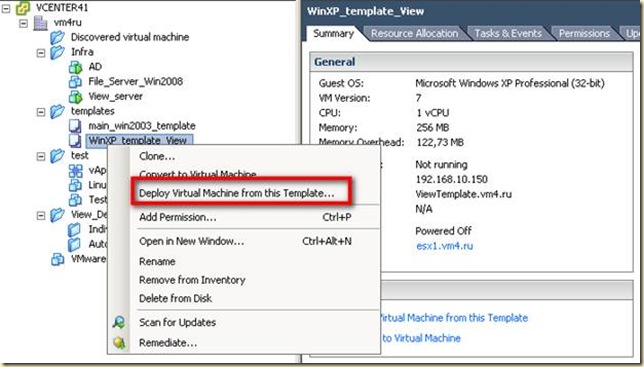
Рисунок 2‑1
Внимание, анимированный gif:

Рисунок 2‑2
3. Настройка виртуального десктопа в View.
Дальнейшие настройки делаются на сервере View. Следует авторизоваться, и перейти к пункту настроек Inventory > Pools.

Рисунок 3‑1
3.1 Отдельная ВМ
Если нам необходим статичный набор из одной или более ВМ, то запустив мастер добавления пула, выбираем Manual Pool.
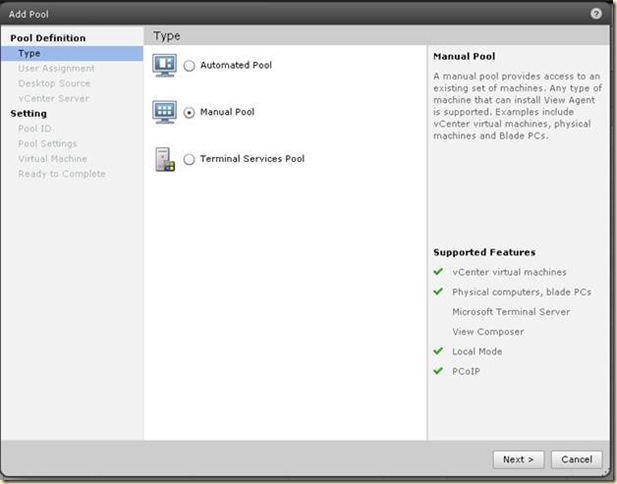
Рисунок 3‑2
Затем нас спрашивают будут ли ВМ жестко привязаны каждая к одному юзеру, или «кто первый встал того и тапки»:
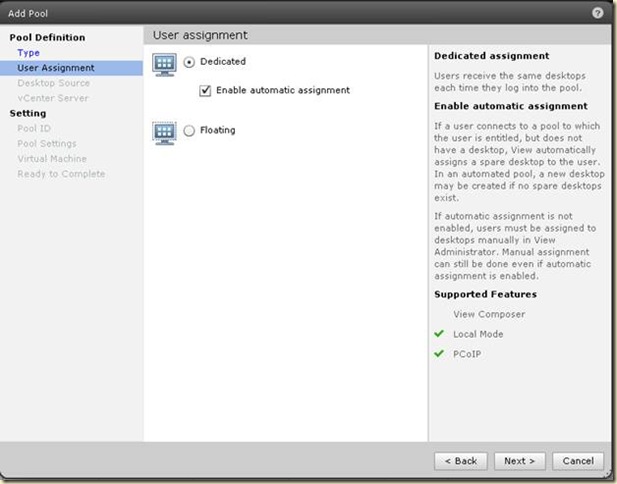
Рисунок 3‑3
Этот пул десктопов View может ссылаться не только на виртуальные машины vCenter (что сейчас надо нам), но и на ВМ не с vSphere, и на физические машины:
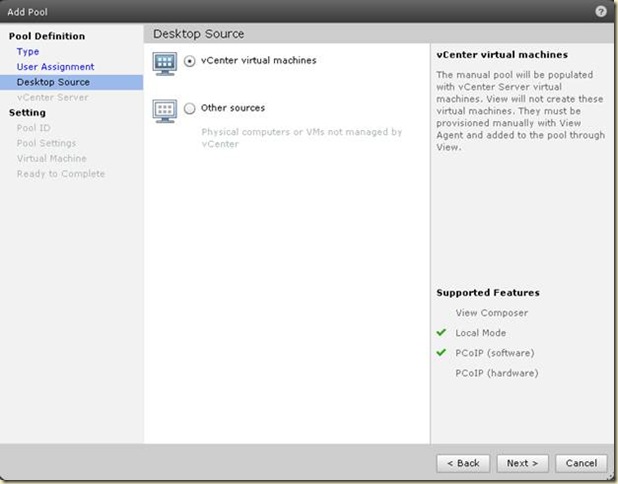
Рисунок 3‑4
Указываем внутреннее имя и отображаемую пользователям метку:

Рисунок 3‑5
Настройки пула сейчас оставляем по умолчанию:

Рисунок 3‑6
На этом шаге View покажет нам список ВМ с десктопными ОС и View Agent внутри. Из списка вы выберем те, которые должны входить в создаваемый пул. Выбор сейчас небогатый:

Рисунок 3‑7
Следующий шаг — назначение группы пользователей из AD, кому будет доступна возможность подключаться к данному пулу при обращении на View Server. Пройдите Inventory > Pools > выберите созданный пул > Entitlements.

Рисунок 3‑8
Нажав эту кнопку, укажите нужную группупользователя.
3.1.1 Проверка подключения к этой ВМ, например с iPad
(В общем-то, этот пункт я добавил только для того, чтобы похвастаться моей гламурной игрушкой :-))
Запускаем нужный клиент:
UPD. Появились родные клиенты под iPad и Android.
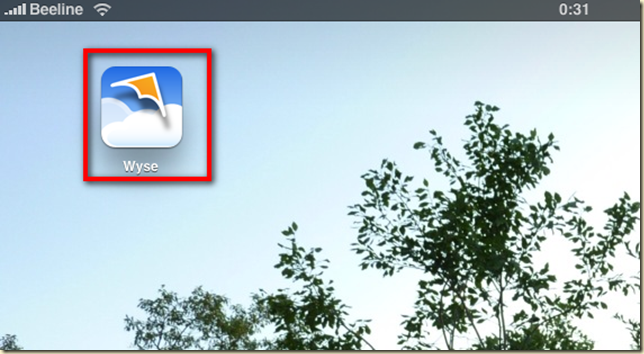
Рисунок 3‑9
Выбираем нужный тип подключения:

Рисунок 3‑10
Указываем параметры подключения:
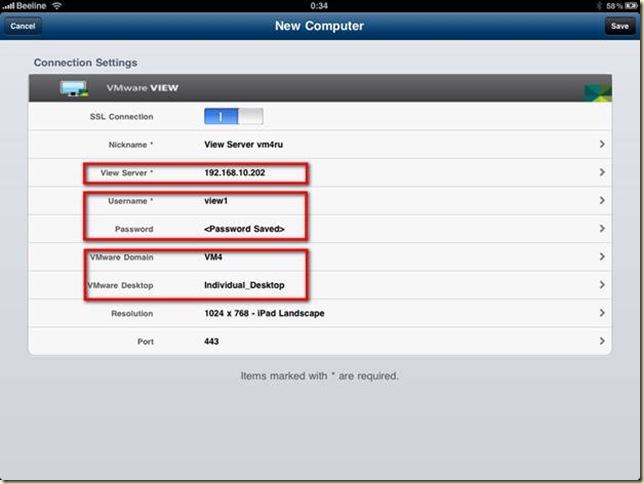
Рисунок 3‑11
Притом домен и доступные (тут — единственный доступный) пулы клиент подсказывает самостоятельно.
И, в общем-то, все:

Рисунок 3‑12

Рисунок 3‑13
3.2 Автоматический пул
Для создания автоматического пула View действия требуются тоже несложные.
Запускаем мастер создания пула, указываем что он автоматический. Затем все просто:

Рисунок 3‑14

Рисунок 3‑15

Рисунок 3‑16

Рисунок 3‑17
Обратите внимание — при моих настройках развертывания (держать одну ВМ наготове, Spare), в vCenter начинается развертывание ВМ:

Рисунок 3‑18
Напоследок, выполните назначение группы для этого пула — Entitlement. А затем — подключайтесь. Например, теперь поговорим про стандартный способ — клиент View.
4. Установка клиента View
Установка клиента View не представляет из себя ни чего-то сложного, ни интересного. Демонстрировать я буду Windows версию клиента — Сетап екзе, некст некст, ентер.
После запуска установленного клиента указываем сервер View для подключения, и авторизуемся.

Рисунок 4‑1
Кстати, как сделать так, чтобы в выпадающем меню заранее было несколько нужных нам вариантов vew серверов — VMware View Client DropDown Menu Automation.
Указываем пользователя:

Затем выбираем требующийся из доступных указанному пользователю пулов View:
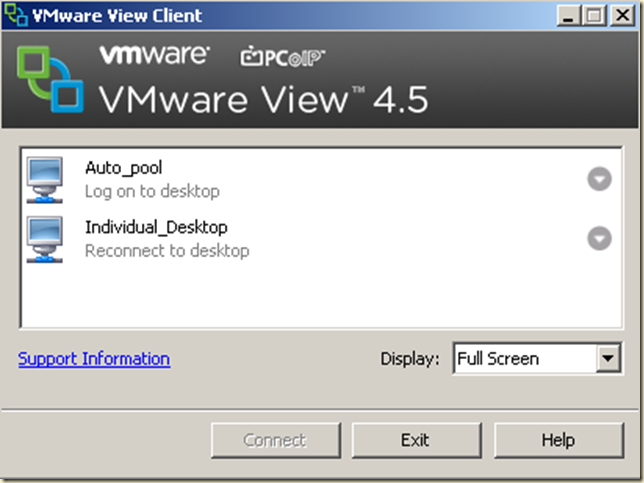
Рисунок 4‑2
И, в общем-то, все.
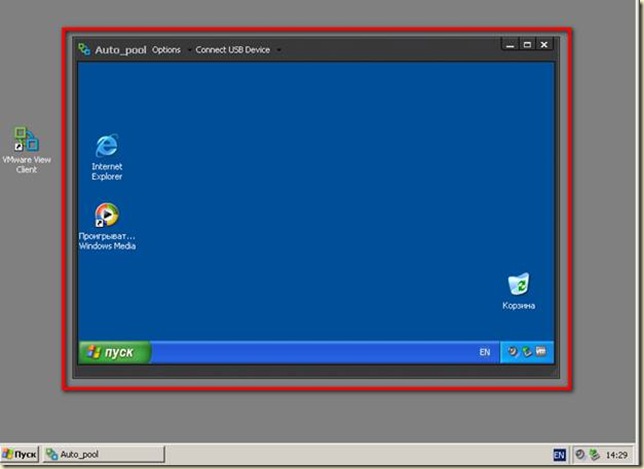
Рисунок 4‑3
5. Создание пула связанных клонов, Linked Clones
Для того, чтобы создать такую хитрую группу ВМ, требуется установить продукт View Composer на сервер vCenter, а затем создать соответствующий пул виртуальных десктопов во View.
5.1 Установка View Composer
Для начала требуется создать базу для Composer, затем ODBC коннектор к ней, и затем уже устанавливать сам Composer.
5.1.1 Настройка БД
Создание базы и коннектора весьма просты. Я приведу самый самый простой вариант — когда Composer использует тот же SQL Express, что и vCenter.
Запустите SQL Server Management Studio Express, правый клик на Databases -> Create New.
Укажите название, все остальное по умолчанию.
Затем запустите Administrative tools -> Data Sources (ODBC), на вкладке System DNS создайте новый коннектор SQL Native Client, используя Windows Authentication. Не забудьте указать использование по умолчанию базы, созданной чуть ранее.
5.1.2 Установка Composer, настройка Composer для View Connection Server
Запустите установку. На шаге Database Information введите имя ODBC коннектора, имя пользователя и пароль оставьте пустыми/ Правда, в доке написано, что здесь следует указать учетку доменного администратора, имейте в виду.
Все.
После завершения установки вернитесь в интерфейс администрирования View.
Зайдите в свойства vCenter, поставьте флажок Composer:

Рисунок 5‑1
Нажмите Add, и укажите доменного пользователя, который затем будет использоваться для ввода в домен связанных клонов.
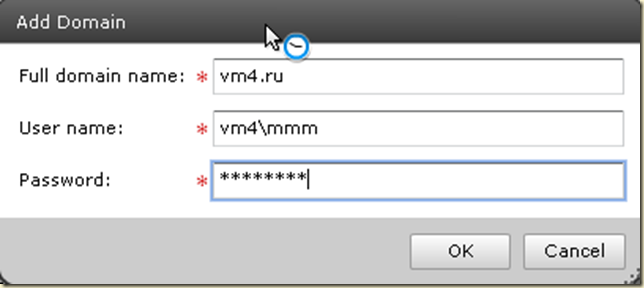
Рисунок 5‑2
5.2 Подготовка виртуальной машины — основы для связанных клонов
Данная виртуальная машина подготавливается практически так-же, как и ВМ для простых пулов, однако существует пара нюансов:
1. Эта ВМ не должна входить в домен AD, а должна являться частью рабочей группы WORKGROUP.
2. После завершения всех настроек ВМ следует выключить, и создать снапшот.
5.3 Настройка пула связанных клонов во View
В интерфейсе View создаем автоматический пул, на шаге vCenter Server указываем, что хотим использовать Composer Linked Clones.

Рисунок 5‑3
На шаге View Composer Disks можем указать использование
· Persistent Disk — это диск для хранения профиля пользователя, чтобы этот профиль не удалялся при очищении дельты системного диска связанного клона. Если вы создаете пул типа Floationg, т.е. без жесткого закрепления ВМ на пользователем, то создание диска для профиля по понятным причинам не предложат.
· Disposable File Redirection — временный диск для размещения файла подкачки и временных файлов гостя.

Рисунок 5‑4
На шаге vCenter Settings требуется указать виртуальную машину, с которой будет создан мастер-образ связанных клонов, и где в иерархии vCenter связанные клоны будут создаваться.

Рисунок 5‑5
Guest Customization теперь умеет использовать не только QuickPrep, но и Sysprep для связанных клонов. Я пока еше не понял чем второй интереснее. Для простоты выберем QuickPrep — эта написанная программистами VMware утилита не будет изменять ничего, кроме имени ВМ, но ввод в домен обеспечит.
Все. После завершения мастера потребуется некоторое время, чтобы vCenter клонировал указанную выше ВМ — ведь мастер-образом, с которого будут загружаться связанные клоны, будет не указанная ВМ, а вот как раз ее клон. Вот так он выглядит с точки зрения vCenter:

Рисунок 5‑6
Затем будет создано минимальное число самих клонов — в соответствии с пунктом настроек пула Provisioning Settings. Каждый клон будет разок перезагружен — из за кастомизации QuickPrep|Sysprep.
Не забыв сначала сделать Entitlements, подключаемся:

Рисунок 5‑7
Конечно, о многом тут еще не рассказано. Я даже список не буду создавать — лень еще много букв писать
Вместо этого я сообщу, что с конца ноября мы начнем читать курс по View версии 4.5. Это будет четырехдневный, очень интересный курс, велкам.
check
Best Answer
Found the Issue. It took over a week and VMWare finally contacted me and gave me an education. So far I have been admining Servers and only RDP to those. For the Desktops my coworker had set all of those up. I needed to install the local agent in windows to make the connection. Makes Sense when I could RPD the desktop but not connect using their pciop crap. I really don’t like these vendor locked Zero Clients.
Was this post helpful?
thumb_up
thumb_down
View Best Answer in replies below
15 Replies
-
I’d normally say just open a ticket with the View team (they are actually really good at finding issues with composing) but since your using a 3rd party composer I’d talk to Unidesk first.
Was this post helpful?
thumb_up
thumb_down
-
Also with Horizon View 6 and the application streaming options have you looked at using a «pure View» solution?
Was this post helpful?
thumb_up
thumb_down
-

Brand Representative for VMware
cayenne
Like John said above, since you can connect to the desktop itself, it is probably a composer/broker issue. I would contact Unidesk and see what they have to say. If you couldn’t even connect to the desktop, then it would be more of a View issue I would think.
Was this post helpful?
thumb_up
thumb_down
-
Thanks. I have created the new desktop in VMware and not in UniDesk. I am trying to isolate an issue we are having. I have opened a support ticket with VMware however since our systems are not down we have not received a call back yet.
Either way even though this desktop is not managed by UniDesk it seems you are saying UniDesk will control the broker anyways and wont let me connect?
Was this post helpful?
thumb_up
thumb_down
-
Thanks. I have created the new desktop in VMware and not in UniDesk. I am trying to isolate an issue we are having. I have opened a support ticket with VMware however since our systems are not down we have not received a call back yet.
Is this a manual Pool, or an automatic pool. if its an automatic linked clone pool your talking Composer potentially being the issue (which a Lot of Unidesk shops tend to not deploy it or keep it updated).
Was this post helpful?
thumb_up
thumb_down
-
This is a Manual Pool My user is assigned the static desktop.
Was this post helpful?
thumb_up
thumb_down
-
sysupgrade wrote:
This is a Manual Pool My user is assigned the static desktop.
Manual pool, you manually cloned, that would be an issue with Agent/Connection server communication.
Check firewall, check activation (If your using MAK instead of KMS this is a common error I believe) and baring the obvious KB’s open a ticket with VMware.
Was this post helpful?
thumb_up
thumb_down
-
For a quick isolation to the connection server/agent, install the View client on a physical PC, and see if you can connect to it (register it as a source and a manual pool).
Was this post helpful?
thumb_up
thumb_down
-
I have opened a ticket with VMWare. Three days in and no response yet.
VMware View Client gives me the same error. What I did is I created a New VM. Attached the ISO for Windows 7 pro Install to the CD drive and installed it manually. I then assigned the VM to the pool and attached my name as assigned user.
I will try to create a new pool and add it just to it.
Was this post helpful?
thumb_up
thumb_down
-
Nope same results when adding to it’s own pool.
Was this post helpful?
thumb_up
thumb_down
-
Found the Issue. It took over a week and VMWare finally contacted me and gave me an education. So far I have been admining Servers and only RDP to those. For the Desktops my coworker had set all of those up. I needed to install the local agent in windows to make the connection. Makes Sense when I could RPD the desktop but not connect using their pciop crap. I really don’t like these vendor locked Zero Clients.
Was this post helpful?
thumb_up
thumb_down
-
sysupgrade wrote:
I really don’t like these vendor locked Zero Clients.
Then don’t buy them. 10Zig makes cheap thin clients that will work with RDP/PCoIP/HDX or whatever.
The reason why people buy them is promised lower management (it doesn’t happen) and in theory lower costs (they use SoC designs so the protocal is baked into the chip). They limit upgrades, don’t do QoS right, don’t do printer redirection and suck in a lot of other ways.sysupgrade wrote:
but not connect using their pciop crap.
PCoIP is insanely better on high latency connections than RDP, or for doing low throughput video etc.
sysupgrade wrote:
Found the Issue. It took over a week and VMWare finally contacted me and gave me an education. So far I have been admining Servers and only RDP to those. For the Desktops my coworker had set all of those up. I needed to install the local agent in windows to make the connection.
Ouch, sorry I didn’t think of this (I assumed you had set it up). It may be worth reading the View deployment guide. Alternative It might be worth calling in a VMware EUC partner to run a VMware View health check, do some training. Its actually a really nice solution from management once everything is setup and working just fine.
Was this post helpful?
thumb_up
thumb_down
-
I didn’t buy the Zero Clients they were here when I got here and my predecessor didn’t realize they were Vendor Specific. VMware recommended them and they bought them. I like Microsoft’s RemoteFX for RDP. It seems to work really well. You are right though PCoIP is better I just don’t like it.
I have signed up for a VMware Course through our Skill Set Vendor. Thank you John you have been very helpful and educational for me.
Was this post helpful?
thumb_up
thumb_down
-
sysupgrade wrote:
I like Microsoft’s RemoteFX for RDP. It seems to work really well. You are right though PCoIP is better I just don’t like it.
RemoteFX is great if you have tons of bandwidth. On a 3G cell link though PCoIP is better.
Why do you not like PCoIP? It has tools that allow real time troubleshooting of jittler/latency/packetloss etc. Honestly outside of being able to copy files in and out, and redirect local drives I can’t think of anything RDP does that is really «better». Also remember View works just with RDP.
Was this post helpful?
thumb_up
thumb_down
-
As I am reading your posts maybe I have been mistaken in my discontent. I have just had nothing but problems with PCoIP connections to our desktops. VMware has several times pointed the fingers at PCoIP and my lack of knowledge and understanding on the protocols doesn’t help. I never know if it is the problem or not. Although with future planning of desktops Using straight RDP for end users there are a ton of free Programs on Android and Apple Devices that allow for connections to their desktops while on wifi somewhere with our VPN. PCoIP doesn’t have the same options to deploy as easy. Or at least I should say I haven’t found any.
Was this post helpful?
thumb_up
thumb_down
Go to vmware
Horizon client for Windows not connecting when assigned VM becomes available.
My google fu has failed me so I’m going to ask ya’ll.
When I have a fully provisioned pool and there is a user assigned to a VM, if the VM is up and running the user can connect to the VM with the windows client without any issues.
If the VM is powered off and a user connects with their windows client, the client has the green bar filling up and says preparing desktop. I can monitor the VM status in vsphere and horizon and see when its up and ready.
The second that horizon shows the VM as available, the windows client errors out and says «the assigned desktop source is not currently available.»
At that point the user can click the try again button and reach their VM, but I’m wondering if there is a way to avoid this all together?
Hi,
I have a major issue with USB redirection….so far two users were affected.
It started happening just yesterday.
So the VMware tech support guy told me to follow the fix mentioned in this link
http://terenceluk.blogspot.com.au/2013/02/vmware-view-virtual-desktop-displays.html
I managed to uninstalled the previous viewagent then installed VMware-viewagent-5.0.1-640055.exe. The previous viewagent was 5.1.2 something like that.
But, the view client would not connect to the vm with the below error message:
The assigned desktop source for this desktop is not currently available. Please try
Connecting to this desktop again later or contact your system administrator.
From view administrator console it says, the agent version is unknown…..also it says the client is unreachable.
so i RDP to the troubled virtual machine then restored it from yesterday. Now i cannot connect via view client 5.3?
Very frustrating to deal with vmware tech support who supposed to be knowledgeable but found them bloody clueless about technical issue about their product…wasted 3 hrs today and the guys at vmware tech support made the bloody situation worst….
How can i fix this ‘unkwown’ agent version in view admin console?
Thanks
